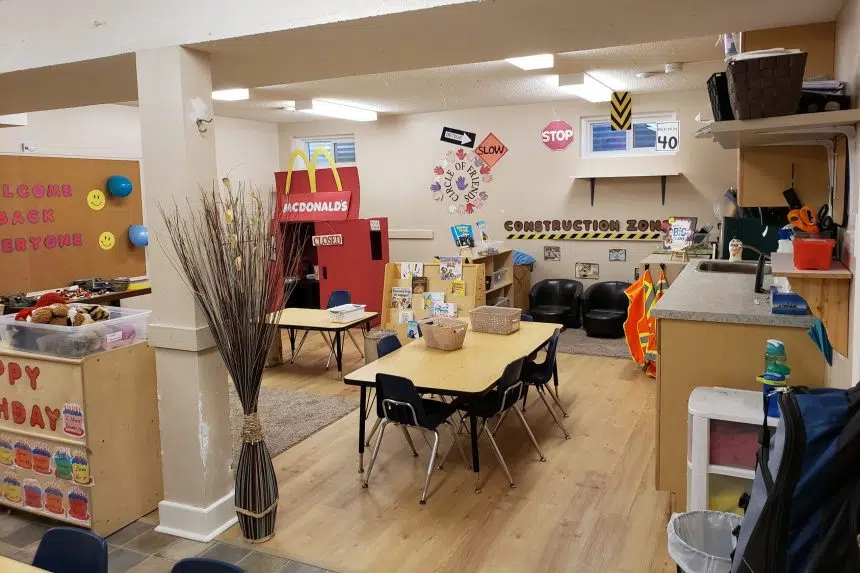From encouraging “air high fives” to socially distanced dropoffs and a lot of cleaning and hand-washing to stop “bad germs,” daycare centres will be explaining a new normal as they welcome back more kids on Monday as part of Phase 3.
On Friday, the provincial government sent out an eight-page document to all licensed child-care centres outlining all of the public health guidelines to keep kids and workers safe from COVID-19. The next phase of opening child-care centres will allow groups of up to 15 kids per room instead of the limit of eight required for the past few months.
Jenifer Kostur is the executive director of Regina’s Solid Futures Learning Centre, which closed for the month of April by choice and then reopened in May with a limited capacity.
Kostur said regular hand-washing has always been a big teaching focus for the daycare centre, but explaining physical distancing is a strange new reality.
“This is a profession where we encourage children to be loving and nurturing and empathetic with their peers and it’s difficult for us to say, ‘Give your friend an air high five’ rather than, ‘Give your friend a hug.’ Those kinds of things are challenging for children,” Kostur said.
The provincial guidelines recommend games for teaching even very young children to stay two arms’ lengths apart and to plan for reduced contact activities like “shadow tag” while avoiding activities that require clustering around a small area.
“Where possible, remove or reduce play with toys that encourage group play in close proximity or increase the likelihood of physical contact. Keep toys that encourage individual play,” the provincial document states.
Kostur said it can be hard to tell kids why they can’t play with sensory items like Play-Doh, water tables, sand tables or rice tables, especially because those activities are so good for keeping young kids calm.
“It’s also challenging for us to explain to the children why we have these new normals in a way that’s understandable for the children but doesn’t frighten them terribly,” Kostur said.
Some of the guidelines around keeping kids together in the same group in the same room with the same worker pose more logistical challenges, particularly around staffing to cover the 10 hours a day the centre is open between 7:30 a.m. and 5:30 p.m.
Kostur points out the centre has to have different workers go into a room in order to relieve someone for a break at lunch or at the end of an eight-hour shift, meaning kids are already exposed to more than one educator.
“Not moving from area to area is extremely challenging as well because let’s face it, we need to disinfect those rooms,” Kostur said.
Obtaining supplies for extra cleaning and sanitizing has also been a challenge for daycare directors like Kostur.
When asking the provincial daycare consultants about new regulations, or inquiring on the business line, Kostur believes some of the new guidelines can be modified in specific circumstances as long as there is a good justification such as something like accommodating shift changes.
Dropoff procedures vary between different daycare centres, with many currently requiring a screening questionnaire about possible symptoms, travel or exposure to COVID-19.
According to the provincial document, “checking temperatures, detailed screening or requiring COVID-19 testing of children and staff are not required or recommended at this time based on current evidence.”
Yet it will be up to parents and daycares to make sure children don’t go to daycare if they have any symptoms. If a child becomes sick at daycare, they will have to be isolated until they are picked up and in those specific scenarios daycare workers who are caring for them should wear masks and gloves.
Daycares are modifying dropoff and pickup procedures to limit parents to the entrance of the building, generally one at a time. While the province suggests placing hand sanitizer with 70 per cent alcohol in locations near entrances for use by parents and workers, the line right below that says it is not recommended for use by children and should be kept out of reach.
As of Monday, Kostur said the Solid Futures Learning Centre would technically have the space to return to full capacity of 50 kids with 15 per room, but Koster said about half of the families have chosen to keep their kids home so there will be 26 kids by the end of this month.
“A lot of our families, they are working from home still and they contact me and say, ‘I’m unsure,’ or, ‘I’m still scared to come. I’m still scared for my child to be in a group setting,’ and I can respect that,” Kostur said. “We disinfect like crazy throughout the day but there’s no guarantee.”
Kostur said the board of directors voted to allow families who are keeping kids home to only pay a minimal holding fee instead of their full price, but those decisions are made month to month and the centre can’t plan for the future very well.
“To be 100 per cent honest, without the Canadian Emergency wage subsidy, we would be pretty looped right now financially, so that’s kind of a huge saving grace for us,” Kostur said.
The centre normally has eight full-time and four part-time daycare workers, but so far Kostur has only been able to rehire seven full-time staff members.
While Kostur understands the information changes almost daily, she is hoping to see improved communication from the Ministry of Education about daycares, noting sometimes she hears updates directly relating to daycares on the news before she gets a direct email.











